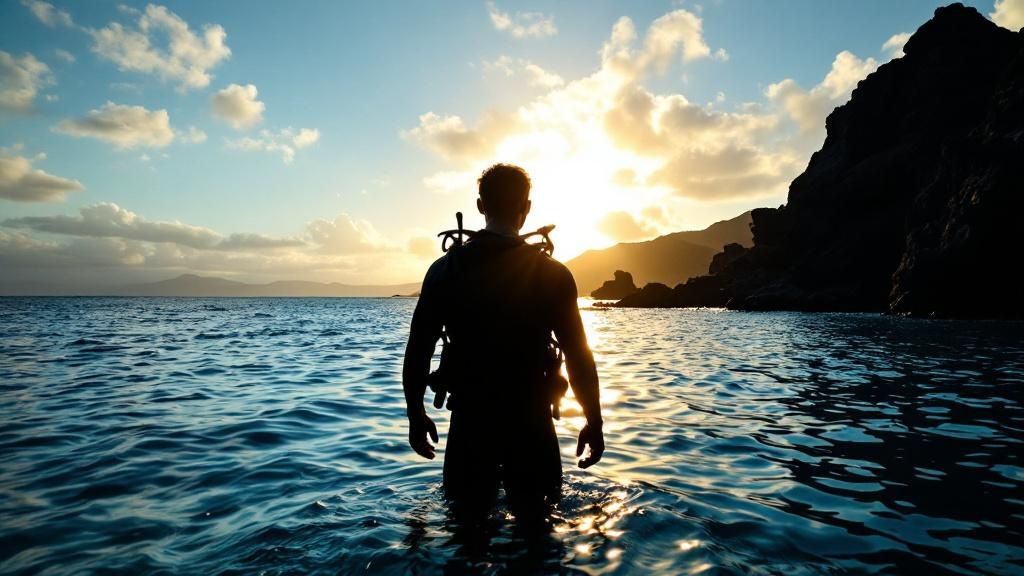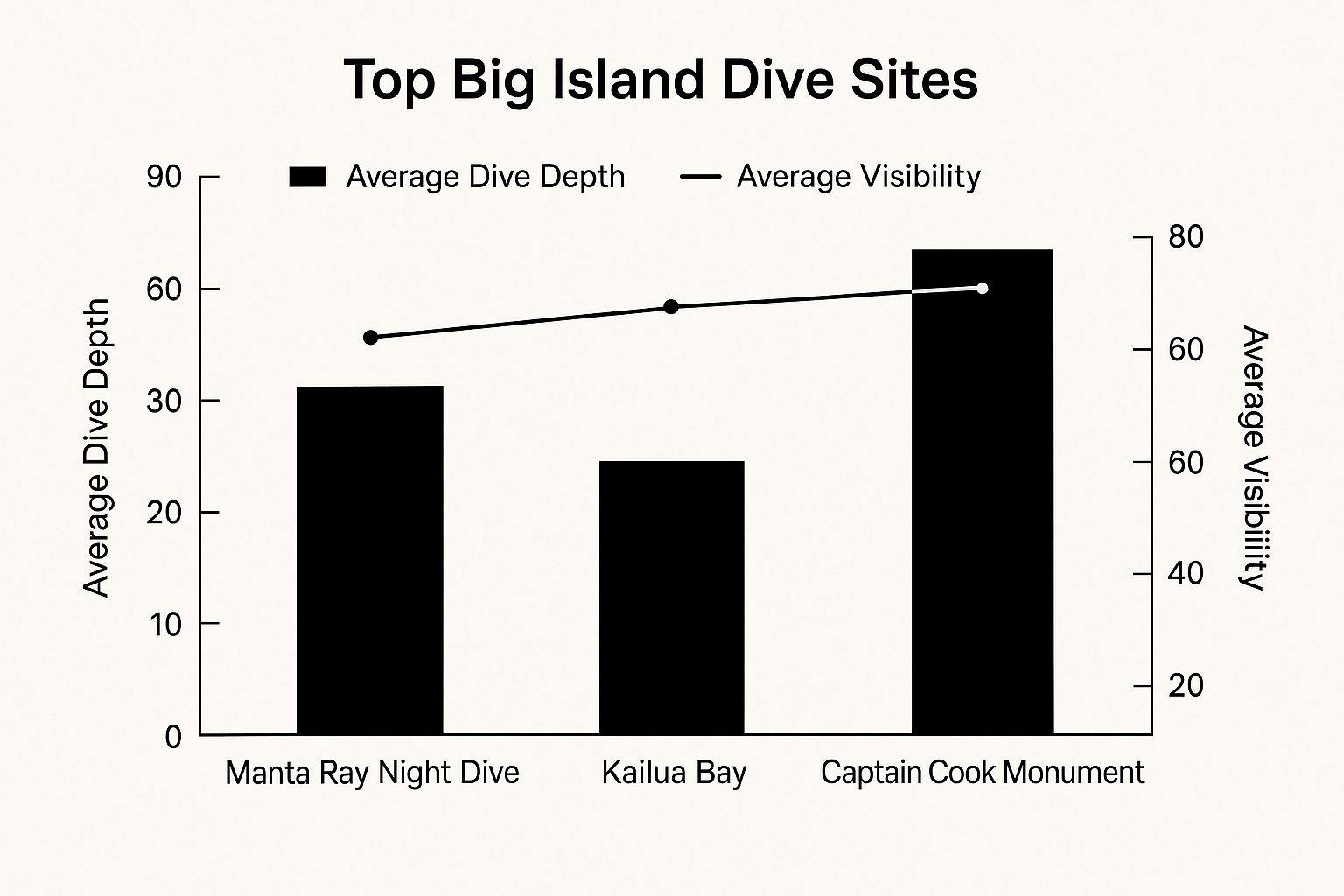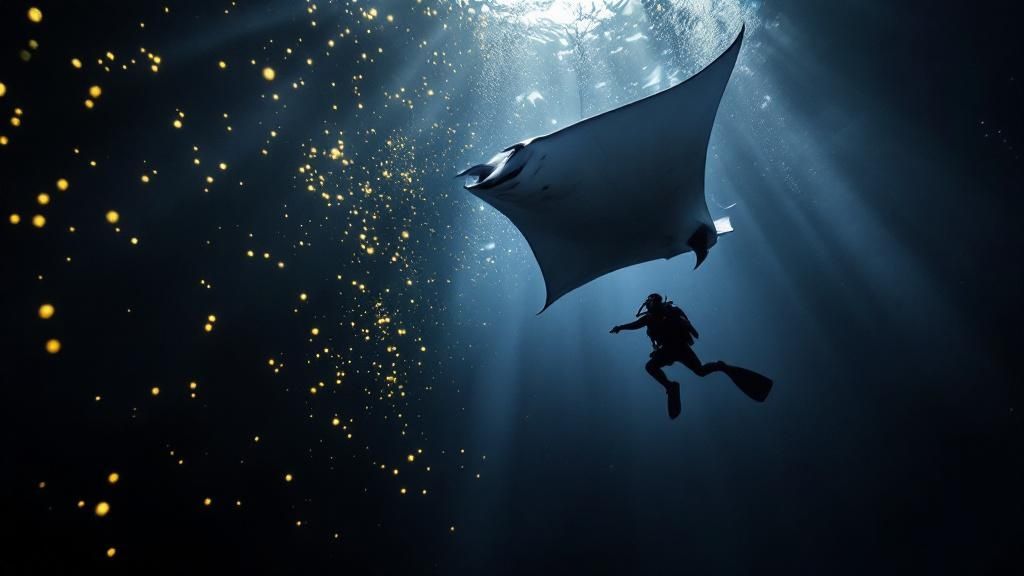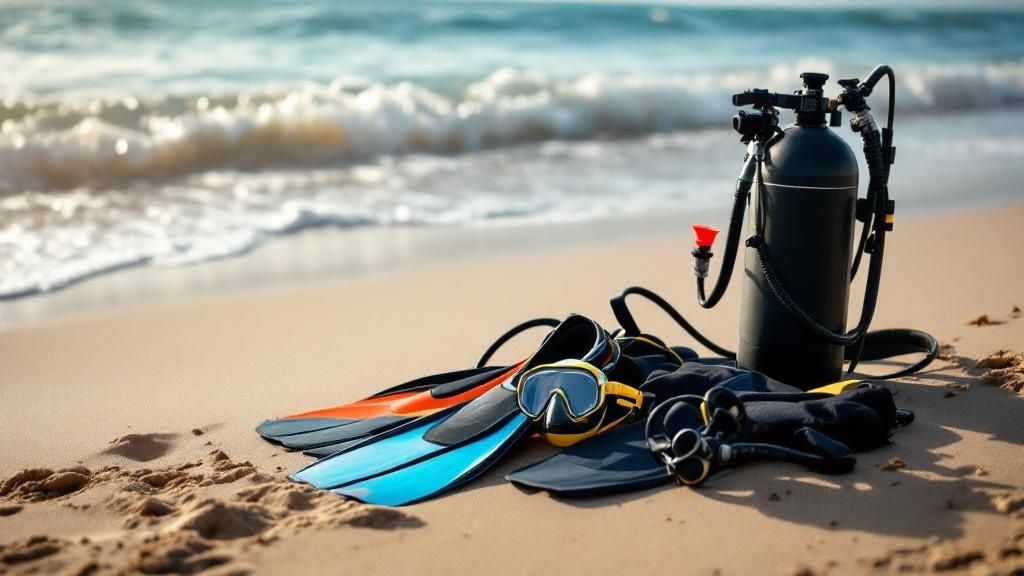Why Big Island Scuba Diving Beats Every Other Hawaiian Spot

Every Hawaiian island offers fantastic diving, but the Big Island stands apart. Its volcanic foundation creates a truly unique underwater landscape. Active lava flows continuously reshape the seabed, forming dramatic lava tubes and pristine coral formations. This ever-changing environment makes for an unparalleled diving experience within the Hawaiian archipelago.
The mineral-rich waters surrounding the Big Island nourish a vibrant and diverse marine ecosystem. This leads to incredible wildlife encounters, as various species are drawn to the nutrient-rich volcanic environment. The Big Island also consistently boasts remarkable visibility, often exceeding 100 feet. This exceptional clarity allows divers to fully appreciate the vibrant colors and intricate details of the underwater world.
Speaking of thriving ecosystems, the Big Island's dive industry itself has a fascinating history. The island's journey to becoming a premier scuba diving destination began in the late 1960s and early 1970s, with diving pioneers overcoming the challenges of limited technology. A key moment was the establishment of Jack's Diving Locker in 1981. Today, they conduct over 25,000 dives annually, contributing to the Big Island's estimated 100,000 certified scuba dives each year. Want to learn more? Explore further at Kona Honu Divers.
Why Professional Divers Choose Big Island Scuba Diving
The Big Island attracts professional divers worldwide for numerous reasons. The unique underwater topography, with its dramatic drop-offs and caverns, presents exciting challenges. The consistent presence of pelagic species, such as manta rays and whales, provides another thrilling dimension.
The Big Island's commitment to marine conservation also plays a significant role. Protected areas and responsible diving practices help ensure the long-term health of these incredible ecosystems. This dedication leads to healthier reefs and more abundant marine life, making for an unforgettable and ethically responsible diving experience. This combination of factors keeps professional divers coming back year after year, eager to explore the constantly evolving underwater realm of the Big Island.
Essential Big Island Dive Sites You Can't Skip
Big Island scuba diving offers incredible variety. From exploring ancient lava tubes to unforgettable manta ray encounters, there's an underwater adventure waiting for everyone. This section explores some of the best dive sites, catering to divers of all skill levels and interests. Whether you're just starting out or a seasoned pro, you'll discover hidden gems and world-famous locations that make Big Island scuba diving truly special.
Top Dive Sites for Every Level
Looking for the perfect dive site? Here are a few fantastic options:
-
Manta Ray Night Dive (Kona): This is a truly magical experience. Witness the graceful ballet of manta rays as they feed on plankton, illuminated by your dive lights. This unique dive is suitable for both snorkelers and divers. The average depth is 65 feet with visibility around 75 feet.
-
Kailua Bay: This sheltered bay is an ideal spot for beginners. With an average depth of 40 feet and 60 feet of visibility, it's a comfortable environment to explore vibrant coral reefs and diverse fish populations.
-
Captain Cook Monument (Kealakekua Bay): Dive into history at the site where Captain Cook first landed. This site boasts excellent visibility, often exceeding 100 feet, and depths reaching 85 feet, making it suitable for a range of skill levels. Learn more at: Big Island Diving.

The infographic above provides a quick comparison of these three dive sites, highlighting their average depth and visibility. Captain Cook Monument offers the deepest dive with the clearest visibility, while Kailua Bay is a shallower, more accessible option for newer divers. The Manta Ray Night Dive, at a moderate depth, focuses on a truly unique wildlife interaction.
Kealakekua Bay, home to the Captain Cook Monument, deserves a special mention. Designated as a Marine Life Conservation District, this area boasts exceptional visibility, frequently over 100 feet. Its protected status ensures a flourishing coral reef ecosystem teeming with a diverse array of marine life. You'll see everything from colorful yellow tangs to parrotfish. This combination of natural beauty and historical significance makes it a must-visit destination for anyone exploring underwater Hawaii. For additional information, check out this link: Kealakekua Bay.
Exploring Beyond the Usual
The Big Island offers even more exciting dive opportunities beyond these popular locations.
The following table summarizes some of the top dive sites on the Big Island:
Big Island Top Dive Sites Comparison: Compare the best diving locations on the Big Island including depth, skill level, and unique features.
| Dive Site | Max Depth | Skill Level | Best Features | Marine Life Highlights |
|---|---|---|---|---|
| Manta Ray Night Dive (Kona) | 65 ft | Beginner – Advanced | Night diving with manta rays | Manta rays, plankton |
| Kailua Bay | 40 ft | Beginner | Sheltered bay, calm waters | Reef fish, coral |
| Captain Cook Monument (Kealakekua Bay) | 85 ft | Beginner – Advanced | Historical site, excellent visibility | Diverse reef fish, coral |
| Kohala Coast Drift Dives | Varies | Advanced | Thrilling drift dives, pelagic encounters | Pelagic fish, coral |
| Lava Tubes & Caverns | Varies | Experienced | Unique geological formations | Various marine life adapted to cave environments |
This table helps compare several popular sites at a glance, considering depth, required skill level, and key features. It’s a useful starting point for planning your Big Island diving adventure.
The Kohala Coast offers thrilling drift dives for experienced divers. These dives provide opportunities to encounter pelagic fish in the strong currents. The Kohala Coast offers a more secluded and ecologically-focused experience.
The Big Island's unique volcanic origins have created fascinating underwater lava tubes and caverns. These geological formations offer an unparalleled adventure, unlike anything else on Earth. These underwater landscapes provide a glimpse into the powerful forces that shaped the Big Island. More information can be found here: All about Big Island scuba diving.
Getting Your Gear Right For Hawaiian Waters

Preparing for Big Island scuba diving means choosing the right equipment. Hawaii's unique conditions, like water temperature, currents, and volcanic dive sites, require careful consideration. Picking the correct gear can greatly improve your dive, making it safer and more enjoyable.
Wetsuit Considerations for Big Island Scuba Diving
Water temperatures around the Big Island change throughout the year. A 3mm wetsuit might be okay in the summer. However, a 5mm wetsuit is generally better for comfort, especially on longer dives or in cooler months. The extra thickness provides better insulation in deeper, colder water. For instance, a 5mm wetsuit offers more protection during night dives or deeper explorations.
Essential Dive Gear Beyond the Wetsuit
Besides a wetsuit, some other equipment is vital for Big Island scuba diving. A dive computer is important for tracking your depth and bottom time for safe diving. A high-quality dive mask and snorkel are also essential for clear vision and breathing at the surface. A well-maintained regulator ensures a reliable air supply underwater, and fins help you move efficiently. You might also be interested in improving your skills: How to master your scuba skills.
Specialty Gear for Enhanced Experiences
Certain gear can make your Big Island scuba diving even better. An underwater camera lets you capture the amazing marine life and volcanic formations. A powerful dive light is a must-have for night dives. It helps with navigation and viewing nocturnal creatures. A slate and pencil are useful for underwater communication, especially during training or when identifying species. These tools can make your underwater experience more interactive and enriching.
Renting vs. Bringing Your Own Gear
You can rent a lot of this equipment locally. However, many divers prefer to bring their own mask, snorkel, and fins for hygiene and comfort. Larger or more specialized gear, like dive computers and underwater cameras, is usually available for rent from reputable dive operators on the Big Island. Renting lets you pack lighter and avoid airline baggage fees. This gives you the right gear without the hassle of transporting it. Thinking about these things beforehand will help you have the best possible Big Island scuba diving experience.
Marine Life Encounters That Make Big Island Special
Big Island scuba diving offers more than vibrant coral reefs. The island's volcanic environment attracts diverse marine life, from native Hawaiian species to migrating animals. This underwater paradise provides unique encounters.
Endemic Hawaiian Species: A Unique Underwater World
The Big Island's isolation has led to the evolution of endemic species found nowhere else. These species are a special highlight of Big Island scuba diving, offering a look into a distinct ecosystem. The Hawaiian Monk Seal, one of the world's most endangered seals, lives in these waters. Vibrant butterflyfish, with patterns and colors unique to Hawaii, dart among the coral.
Seasonal Visitors: Migrating Wonders of the Pacific
The Big Island lies along migration routes for several impressive marine animals. Humpback whales, reaching lengths of 40-50 feet, come to Hawaiian waters during winter (December to May) to breed and give birth. Divers might hear their songs underwater during these months. Manta rays, with wingspans up to 18 feet, gather at feeding grounds, creating spectacular displays as they filter plankton. You might be interested in: Manta Ray Night Snorkel Kona.
The Island's Volcanic Influence: A Habitat For All
The Big Island's volcanoes shape its underwater environment. Lava flows create lava tubes and caverns, providing shelter for marine life. This geology supports both reef species, like colorful parrotfish and surgeonfish, and deep-water visitors drawn to the nutrient-rich waters. This creates a thriving ecosystem for divers.
Respectful Wildlife Interactions: Protecting Our Ocean Treasures
Responsible interaction with wildlife is crucial. Maintain a respectful distance from marine life, avoiding contact that could disrupt their behavior or damage the ecosystem. Practice good buoyancy control to avoid touching the seabed or coral. These actions protect the marine environment for future generations to enjoy Big Island scuba diving. Responsible photography contributes to conservation.
Photography Tips for Big Island Scuba Diving: Capture the Magic
Capturing Big Island scuba diving's beauty requires adapting techniques. The clear water allows for stunning wide-angle shots of reefs and lava formations. Using strobes or underwater lights correctly enhances the colors of fish and coral. Capturing manta rays on a night dive requires careful lighting and anticipation. Understanding these details helps create magical underwater images.
Seasonal Patterns For Optimal Wildlife Experiences
Planning your dive around seasonal patterns improves chances of specific wildlife encounters. The best time for manta ray viewing is at night, when they feed on plankton. Whale watching season peaks between January and March. Aligning your trip with these natural rhythms maximizes opportunities for unforgettable interactions with the Big Island's marine life.
Choosing Dive Operators Who Actually Deliver

Not all Big Island scuba diving operators are created equal. The operator you choose can significantly impact your overall diving experience. A subpar operator can quickly turn a dream dive trip into a nightmare, while a great one can create memories that last a lifetime. This is why careful research and selection are essential for a safe and enjoyable underwater adventure.
Key Considerations For Selecting a Dive Operator
Several key factors set exceptional dive operators apart. Safety records should always be your top priority. Look for operators with a demonstrable commitment to safety protocols and a history of incident-free dives. Equipment quality is also paramount. Well-maintained gear ensures a reliable and safe dive, minimizing the risk of equipment malfunctions underwater.
Local expertise is another crucial aspect of a successful Big Island scuba diving experience. Guides familiar with the area's unique dive sites, currents, and marine life can significantly enhance your dives. They can point out interesting creatures and formations you might otherwise miss. If you’re in the Kona area, you might find this helpful: Kona dive shops near me.
Evaluating Certifications, Group Sizes, and Environmental Practices
When evaluating potential dive operators, pay close attention to their certifications. Ensure they adhere to recognized industry standards, such as those set by PADI or SSI. These certifications indicate a commitment to professional training and adherence to established safety guidelines.
Group size is another factor to consider. Smaller groups allow for a more personalized experience, better interaction with the dive guide, and more attention to individual divers' needs. Finally, assess the operator’s commitment to environmental practices. Responsible operators prioritize sustainable diving practices that protect the fragile marine ecosystem.
The following table summarizes key criteria to consider when selecting a dive operator on the Big Island. It provides a framework for asking the right questions and identifying potential warning signs.
Big Island Dive Operator Selection Criteria
| Criteria | What to Look For | Questions to Ask | Warning Signs |
|---|---|---|---|
| Safety Record | Proven commitment to safety protocols, well-maintained equipment, low incident rate | What are your safety procedures? How often do you service your equipment? | Outdated equipment, lack of clear safety briefings, dismissive attitude towards safety concerns |
| Guide Experience | Local expertise, familiarity with dive sites and marine life, strong communication skills | How long have your guides been diving in this area? What kind of marine life can we expect to see? | Guides unfamiliar with local conditions, inability to answer questions about marine life |
| Group Size | Smaller groups for personalized attention | What is the maximum number of divers per guide? | Unusually large groups, crowded dive boats |
| Environmental Practices | Commitment to sustainable diving, respect for marine life | What are your environmental policies? How do you minimize your impact on the reef? | Disregard for environmental regulations, careless handling of marine life |
By carefully considering these criteria, you can choose a dive operator that prioritizes safety, quality, and sustainability. This will greatly enhance your chances of having a truly memorable diving experience on the Big Island.
Matching Your Dive Experience and Comfort Level
Choosing an operator that aligns with your experience level is crucial for a positive dive experience. Some operators specialize in beginner-friendly dives, offering introductory courses and shallow-water explorations. Others cater to more experienced divers, organizing advanced technical dives and exploring deeper, more challenging sites.
Clearly communicate your experience level and comfort in the water to ensure a good fit. This allows the operator to tailor the dive experience to your specific skills and preferences, maximizing both safety and enjoyment. Some operators offer a wide range of services, from guided tours for beginners to advanced technical diving expeditions. Ultimately, look for companies that prioritize your safety and satisfaction. This will undoubtedly lead to a more rewarding Big Island scuba diving experience.
Smart Planning For Your Big Island Diving Adventure
Turning your Big Island scuba diving dreams into a reality takes careful planning. This ensures you get the most out of your underwater adventures. This section covers key aspects of planning your trip, from picking the best time to go to budgeting wisely.
Optimal Timing: Weather, Marine Life, and Crowds
Timing is everything when planning your Big Island scuba diving adventure. Hawaii boasts pleasant weather all year, but some periods offer superior diving conditions. Summer (May-September) typically brings calmer seas and warmer water, perfect for new divers. However, this is also the busiest tourist season, meaning more crowded dive sites. You might be interested in: Why You Should Consider Scuba Diving Hawaii.
Winter (October-April) offers cooler water and larger waves, but presents opportunities to encounter migrating humpback whales. The shoulder seasons (April-May and September-October) provide a good balance of pleasant weather, fewer crowds, and potentially better prices.
Considering Marine Life Seasons
Don't forget about marine life seasons. Manta ray sightings are common throughout the year, but humpback whale season runs from December to May. Researching these patterns can help you customize your trip for specific wildlife viewing.
Crafting Your Big Island Diving Itinerary
A well-structured diving itinerary helps you maximize your exploration of the Big Island's diverse underwater world. Plan a mix of dives to experience various locations. For example, a morning coral reef exploration could be followed by an exciting night dive to see unique nocturnal marine life.
Think about factors like travel time between sites and required surface intervals between dives. Building in some flexibility allows you to adapt to weather changes or unexpected opportunities. Balance your diving with other island activities for a well-rounded trip.
Practical Tips: Accommodations, Transportation, and Budgeting
Choosing accommodations near popular diving areas cuts down on travel time, allowing you more time underwater. Consider factors like gear storage and proximity to dive operators.
Transportation logistics for your dive gear are also important. Decide whether to rent gear locally or bring your own. If bringing your own, remember to factor in airline baggage fees and transport to your accommodations.
Budgeting and Dive Insurance
Realistic budgeting ensures a stress-free diving experience. Research the costs of dive tours, certifications (if needed), equipment rentals, and lodging. Explore cost-saving options like booking packages or using early bird discounts. Never compromise on safety or the quality of your diving experience to save money. Dive insurance offers financial protection in case of accidents or unforeseen events.
By addressing these practical matters, you'll ensure a smooth and enjoyable Big Island scuba diving adventure. This detailed planning frees you to focus on the underwater magic and make lasting memories.
Making Every Dive Count: Advanced Strategies
Big Island scuba diving offers amazing opportunities to move beyond basic underwater tourism. This section explores strategies to elevate your diving experience, creating lasting memories and deeper connections with Hawaii's unique underwater world.
Mastering Underwater Photography in Hawaiian Waters
The crystal-clear waters surrounding the Big Island provide perfect conditions for underwater photography. However, capturing the vibrant marine life and dramatic volcanic formations requires specific techniques. Consider investing in a wide-angle lens to capture the scale of the reefs and lava formations.
Proper use of strobes or underwater lights is essential to illuminate the vibrant colors of the coral and fish, especially in deeper waters or during night dives. For example, when photographing manta rays during a night dive, carefully positioned lighting can create stunning images.
Expanding Your Dive Skills With Specialty Courses
Enhance your Big Island scuba diving adventure by expanding your skill set through local specialty courses. Obtain a night diving certification to witness the magical transformation of the reef after sunset and observe unique nocturnal species.
An underwater naturalist program deepens your understanding of Hawaiian marine ecosystems, allowing you to identify various species and their roles in the delicate balance of the reef. These educational experiences add layers of appreciation to every dive.
Beyond the Dive: Connecting With the Island's Culture and Conservation
Your Big Island experience extends beyond the water. Connect with the local diving community to discover insider tips and hidden gems. Many operators and dive shops host events and gatherings, offering opportunities to share stories and learn from experienced divers.
Consider supporting local conservation efforts through volunteer programs or donations to organizations dedicated to protecting Hawaiian reefs.
Preserving Your Memories and Planning Future Adventures
Documenting your dives through photography and journaling creates lasting keepsakes of your underwater adventures. Organize your photos and videos, adding captions and descriptions to recall specific details of each dive.
This not only preserves your memories but can also inspire future diving adventures. Your Big Island scuba diving experience can be a springboard to explore other dive destinations worldwide. Consider the skills and knowledge you've gained in Hawaiian waters as a foundation for exploring new underwater landscapes and marine ecosystems.
Ready to experience the magic of Big Island scuba diving? Kona Honu Divers, Hawaii's top-rated scuba diving company, offers exceptional dive tours, courses, and package deals. With over 200 years of combined industry experience, their custom dive boats, meticulous gear maintenance, and knowledgeable crew ensure an unforgettable underwater adventure. Explore their website to learn more and book your dive today: Kona Honu Divers
